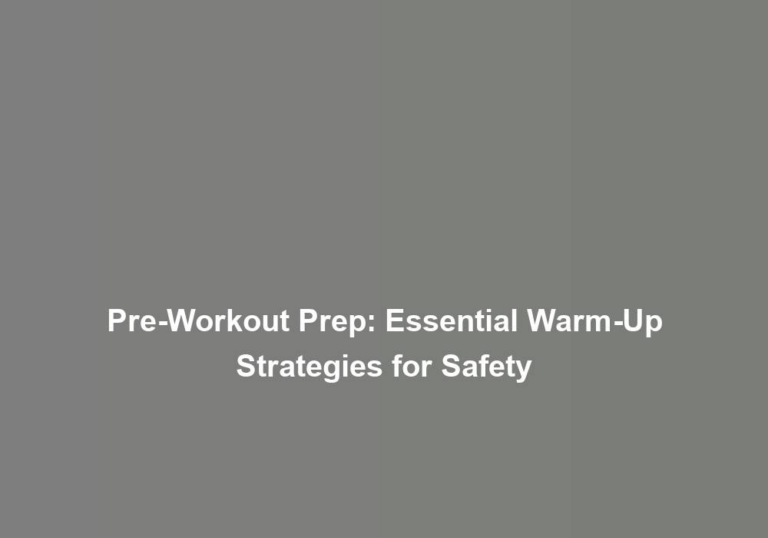Warm-Up Wisdom: Effective Techniques for Injury Prevention
You know how sometimes you start your workout without properly warming up, and then later regret it when you feel a twinge or strain? Well, thereG??s a reason why warm-ups are so important when it comes to injury prevention. Whether youG??re a regular at the gym, a weekend warrior, or an athlete, incorporating effective warm-up techniques into your routine can make a significant difference in keeping your body safe and primed for physical activity. From dynamic stretching to foam rolling and activation exercises, thereG??s a wealth of wisdom to explore when it comes to injury prevention through warm-ups.
The Importance of Warm-Ups
To prevent injury and optimize performance, warming up before physical activity is a crucial step that should not be overlooked. Pre-exercise preparation is essential for injury prevention and ensuring workout safety. A proper warm-up routine can significantly reduce the risk of injuries such as muscle strains and joint sprains. This is achieved by gradually increasing blood flow to the muscles, elevating body temperature, and improving flexibility.
During a warm-up, the bodyG??s physiological responses prepare it for the upcoming physical demands. The heart rate gradually increases, enhancing blood flow to the muscles and preparing them for activity. Additionally, warm-up exercises help to lubricate the joints, making movements smoother and reducing the risk of joint-related injuries. By incorporating dynamic movements that mimic the activity to follow, the neuromuscular system becomes activated, enhancing coordination and proprioception.
Research consistently demonstrates the benefits of a proper warm-up in injury prevention and performance optimization. Athletes and individuals engaging in physical activity can significantly benefit from incorporating specific warm-up routines tailored to their activities. Understanding the importance of a warm-up not only from an injury prevention perspective but also in enhancing overall performance can motivate individuals to prioritize this crucial aspect of their exercise regimen.
Dynamic Stretching Techniques
Incorporate dynamic stretching into your warm-up routine to engage in active, controlled movements that prepare your muscles for the upcoming physical activity. Dynamic stretching involves moving parts of your body and gradually increasing reach, speed of movement, or both. This type of stretching can help improve your flexibility gains and enhance athletic performance by priming your body for the specific movements it will be performing during exercise.
| Dynamic Stretching Techniques | Benefits |
|---|---|
| Leg swings | Increases range of motion in the hips and legs, prepares lower body for running or jumping activities. |
| Arm circles | Enhances shoulder mobility and flexibility, ideal for various upper body exercises. |
| Walking lunges | Improves hip flexibility and strengthens the leg muscles, beneficial for activities like sprinting or agility drills. |
| Torso twists | Engages the core, stretches the spine, and prepares the body for rotational movements such as in tennis or golf. |
Engaging in dynamic stretching before your workout can lead to greater flexibility gains. This is important because improved flexibility can contribute to better posture, reduced risk of injury, and enhanced athletic performance. Moreover, dynamic stretching techniques are designed to replicate the movements you will perform during your workout, making it an effective way to prepare your body for the physical demands it will face. By incorporating dynamic stretching into your warm-up routine, you are actively investing in injury prevention and setting the stage for a successful and fulfilling workout.
Benefits of Foam Rolling
Foam rolling can be an effective technique for reducing muscle tension and improving flexibility, making it a valuable addition to your warm-up routine. When you engage in foam rolling, youG??re applying pressure to specific muscles, which can help release tension and improve blood flow to the targeted areas. This myofascial release technique aids in breaking up adhesions between the muscle and its surrounding connective tissue, promoting better mobility and function.
One of the primary benefits of foam rolling is its potential to enhance post-exercise recovery. By incorporating foam rolling into your cool-down routine, you can help reduce muscle soreness and speed up the recovery process. Research suggests that foam rolling can alleviate delayed onset muscle soreness (DOMS) and improve overall recovery time, allowing you to bounce back more quickly and feel ready for your next workout.
Additionally, foam rolling can contribute to better flexibility and joint range of motion, which are crucial for injury prevention and overall physical performance. By targeting tight areas and releasing muscle tension, you can enhance your bodyG??s ability to move more freely and efficiently during exercise.
Incorporating foam rolling into your warm-up and cool-down routine can provide notable benefits for both your immediate performance and long-term physical health. By taking the time to engage in this practice, youG??re investing in the well-being of your muscles and joints, ultimately supporting your fitness journey.
Activation Exercises for Injury Prevention
Get ready to take your injury prevention routine to the next level with activation exercises. Dynamic stretches and muscle activation drills are key components to prepare your body for physical activity. These exercises help activate the muscles youG??ll be using during your workout, reducing the risk of injury and improving overall performance.
Dynamic Stretches
Activate your muscles and prepare your body for physical activity with dynamic stretches, essential for injury prevention and improved performance. Dynamic stretches are flexibility exercises that involve continuous movement, mimicking the actions youG??ll perform during your workout or sport. By incorporating dynamic stretches into your warm-up routine, you can enhance your range of motion, improve muscle flexibility, and increase blood flow to your muscles, all of which contribute to injury prevention. These exercises also help in movement preparation, priming your nervous system and muscles for the activity ahead. Dynamic stretches are particularly effective before activities that involve running, jumping, or rapid direction changes. Including dynamic stretches in your warm-up routine can help you perform at your best while reducing the risk of injury.
Muscle Activation Drills
Muscle activation drills are crucial for injury prevention and can be integrated into your warm-up routine to prepare your body for physical activity. Stability exercises, a type of muscle activation drill, target specific muscle groups to improve joint stability and control. These exercises help activate the muscles that support and protect your joints, reducing the risk of injury during physical activity. Incorporating stability exercises into your warm-up routine can enhance movement preparation, ensuring that your muscles are ready for the demands of your workout or sports activity. By engaging in targeted muscle activation drills, you can improve your overall movement quality and reduce the likelihood of muscular imbalances that may lead to injury. Prioritizing these drills in your warm-up routine can significantly contribute to injury prevention and long-term physical well-being.
Incorporating Mobility Drills
Incorporating mobility drills into your warm-up routine can significantly improve joint range of motion and reduce the risk of injury during your workout. Mobility drills are specifically designed to target and enhance the flexibility of your joints and muscles, allowing for better overall movement and function. When you engage in mobility drills as part of your warm-up, you are preparing your body for the physical demands of exercise, which can ultimately lead to a more effective and safer workout.
Flexibility exercises, such as dynamic stretching and controlled movements through a full range of motion, can help to increase blood flow to the muscles, improve muscle elasticity, and enhance overall joint flexibility. By incorporating these types of exercises into your warm-up routine, you are actively promoting better functional movement patterns and reducing the likelihood of experiencing strains, sprains, or other exercise-related injuries.
Mobility drills can also help to address any imbalances or asymmetries in your movement patterns, which are common precursors to injury. By focusing on specific areas of the body that may be tighter or less mobile, you can gradually improve your overall movement quality and reduce the risk of overcompensation or undue stress on particular joints or muscles.
Incorporating mobility drills into your warm-up routine is a proactive approach to injury prevention, as it sets the stage for a more effective and safer workout experience. By prioritizing joint range of motion and flexibility during your warm-up, you are taking important steps to safeguard your body against potential exercise-related injuries.
Cool-Down Strategies
To ensure a comprehensive approach to injury prevention, it is crucial to conclude your workout with effective cool-down strategies that build upon the improved joint range of motion and flexibility achieved through mobility drills. Cooling down is an essential part of your post-exercise routine as it allows your body to transition from a state of exertion to a state of relaxation. This phase of your workout not only aids in muscle recovery but also plays a crucial role in reducing the risk of injury.
Cool-Down Strategies
| Cool-Down Strategies | Description | Benefits |
|---|---|---|
| Gentle Stretching | Engage in static stretches targeting major muscle groups. Hold each stretch for 15-30 seconds. | Enhances flexibility, reduces muscle tension, and promotes relaxation. |
| Deep Breathing | Practice deep diaphragmatic breathing to calm the nervous system and facilitate the removal of waste products from the muscles. | Promotes relaxation, reduces stress, and aids in the recovery process. |
| Light Aerobic Exercise | Engage in low-intensity activities such as walking or cycling for 5-10 minutes. | Helps to gradually lower heart rate, prevent blood pooling, and promote circulation for better recovery. |
Incorporating these cool-down strategies into your post-exercise routine will not only aid in muscle recovery but also contribute to an overall sense of well-being. By prioritizing these relaxation techniques, you can optimize the benefits of your workout while minimizing the risk of injury.
Conclusion
So there you have it! Warm-ups are the secret weapon for injury prevention. By incorporating dynamic stretching, foam rolling, activation exercises, mobility drills, and cool-down strategies into your routine, you can become practically invincible! Say goodbye to those nagging aches and pains and hello to a body thatG??s ready to take on anything. Keep up the good work and stay injury-free!







